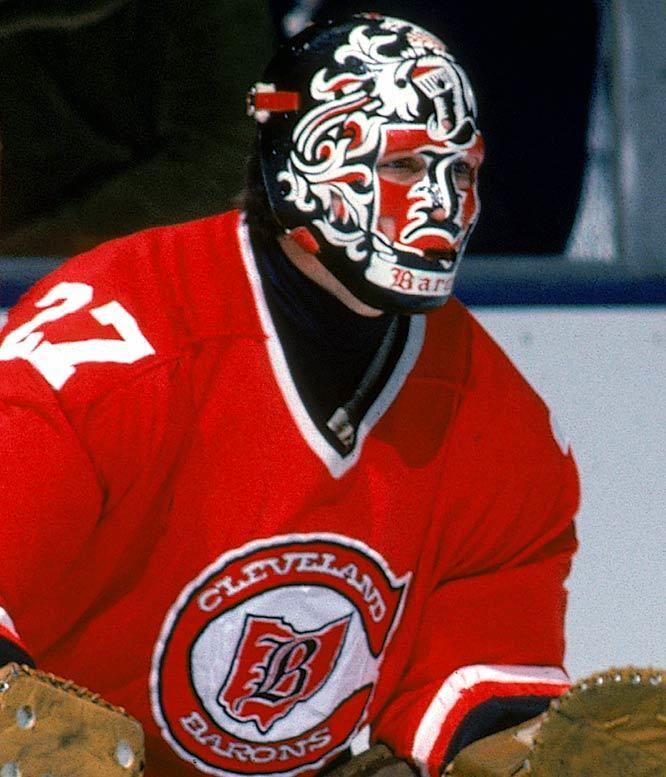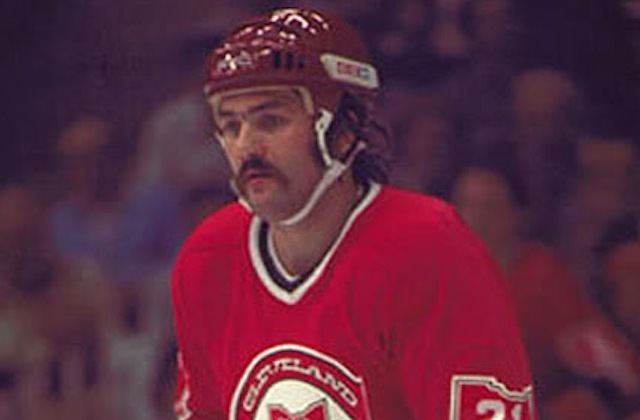Arena Richfield Coliseum City Richfield | Colors Red, black and white Founded 1976 Color Red, black and white | |
 | ||
History California Seals1967Oakland Seals1967–1970California Golden Seals1970–1976Cleveland Barons1976–1978(Team merged into Minnesota North Stars on June 14, 1978) | ||
The Cleveland Barons were a professional ice hockey team in the National Hockey League (NHL) from 1976 to 1978. They were a relocation of the California Golden Seals franchise, which had played in Oakland since 1967. After only two seasons, the team merged with the Minnesota North Stars (now the Dallas Stars). As a result the NHL fielded only 17 teams during the 1978–79 season.
Contents
- History
- Merger and aftermath
- Season by season record
- Team captains
- First round draft picks
- Head coach
- General managers
- References
As of 2017, the Barons remain the last franchise in the four major North American sports leagues to cease operations. Ohio did not have another NHL team until the Columbus Blue Jackets joined the league in 2000.

History

After new arena plans in San Francisco were cancelled, the NHL dropped its objection to a relocation of the troubled California Golden Seals franchise from Oakland. Minority owner George Gund III persuaded majority owner Melvin Swig to move the team to his hometown of Cleveland for the 1976–77 season. The team was named "Barons" after the successful team, in the American Hockey League (AHL), that played in the city from 1929 to 1973. The AHL Barons' owner, Nick Mileti, moved that team to Florida in favour of his Cleveland Crusaders team in the brand new World Hockey Association (WHA).

Cleveland had been mentioned as a possible NHL city as early as the 1930s, when the then-struggling Montreal Canadiens considered moving there. It had also been turned down for an NHL expansion team on three previous occasions in the 1950s and 1960s.
The Barons played in the suburban Richfield Coliseum in Richfield, Ohio, an arena originally built for the WHA’s Crusaders (who left to become the Minnesota Fighting Saints for the 1976-77 WHA season on the Barons' arrival) and the NBA’s Cleveland Cavaliers. The Richfield Coliseum had the then-largest seating capacity in the NHL, at 18,544.
The NHL approved the move to Cleveland on July 14, 1976, but details were not finalized until late August, and there was little time or money for promotion of the new team. The Barons never recovered from this lack of visibility. They would never come close to filling the Coliseum in their two years in Cleveland. The team’s home opener on October 7, 1976, only drew 8,900 fans. They only drew 10,000 or more fans in seven out of 40 home games, and attendance was actually worse than it had been in Oakland. The Barons were also troubled by an unfavorable lease with the Coliseum.
In January 1977 Swig hinted the team might not finish the season because of payroll difficulties. He asked the Board of Governors for a bailout. The board refused to believe that the Barons' situation was that dire; no NHL team had folded since 1942. They turned Swig's request down almost out of hand. The situation quickly deteriorated; team workers went unpaid for two months. The bottom fell out in February, when the team missed two payrolls. The league seriously considered folding the team and holding a dispersal draft of the players. By then, some of the Barons’ players were actively being courted by other teams. By February 18, the players had lost their patience, and threatened not to take the ice for their game against the Colorado Rockies. Wanting to avoid the embarrassment of a player strike, as well as a team folding at mid-season (the latter had previously happened in the rival WHA), the league and the NHLPA made a last-minute $1.3 million loan to allow the Barons to finish the season. After the team finished last in the Adams Division yet again, Swig sold his interest to Gund and his brother Gordon.
For 1977–78, the Gunds poured money into the team, and it seemed to make a difference at first. The Barons stunned the defending Stanley Cup champion Montreal Canadiens on November 23 before a boisterous crowd of 12,859. After a brief slump, general manager Harry Howell pulled off several trades in an attempt to make the team tougher. It initially paid off, and the Barons knocked off three of the NHL’s top teams, the Toronto Maple Leafs, New York Islanders and Buffalo Sabres in consecutive games in January 1978. A few weeks later, a record crowd of 13,110 saw the Barons tie the Philadelphia Flyers 2–2. It did not last; a 15-game losing skid knocked the Barons out of playoff contention.
Merger and aftermath
After the season, the Gunds tried to buy the Coliseum, but failed. With the Barons barely registering as a blip on Cleveland's sports landscape, the Gunds searched for a way out. Meanwhile, the Minnesota North Stars were facing financial difficulties similar to those weighing down the Barons. Fearing that two franchises were on the verge of folding, the league granted approval for the two teams to merge on June 14, 1978. The merged team retained the North Stars' name, colors and history. However, the wealthier Gunds were majority owners, and the North Stars assumed the Barons’ place in the Adams Division. They later moved to the Norris Division in the league's 1981 realignment. In 1991, the Gunds were chosen as inaugural owners of the new San Jose Sharks expansion franchise, selling their North Stars shares to a new ownership group. The NHL arranged a special Dispersal and Expansion Draft, which allowed the Sharks to take 16 North Stars players in a dispersal draft, with both teams then allowed to choose players in an expansion draft.
The dispersal to San Jose had the effect of reversing the original Barons/North Stars merger, with the Sharks occupying the same market as the Golden Seals did prior to their move to Cleveland. The new North Stars owners ultimately moved their team to Dallas as the Dallas Stars in 1993. The Gunds later moved an existing American Hockey League team to Cleveland, operating the minor-league Cleveland Barons from 2001 to 2006.
The NHL worked to keep interest in hockey alive in Ohio. The Pittsburgh Penguins, who from 1978-1991 were owned by Northeast Ohio native Edward DeBartolo, Sr., would play two "home" games at the Richfield Coliseum in the early 1990s before the arena was demolished and the land added to Cuyahoga Valley National Park. The NHL returned to Ohio in 2000 with the expansion Columbus Blue Jackets.
Dennis Maruk was the last Baron (and last Golden Seal as well) to be active in the NHL, retiring from the North Stars after the 1988–89 season with 356 goals in 888 games.
Season-by-season record
Note: GP = Games played, W = Wins, L = Losses, T = Ties, Pts = Points, GF = Goals for, GA = Goals against, PIM = Penalties in minutes
Team captains
First round draft picks
selection made by California Golden Seals as the move to Cleveland had not yet taken place
